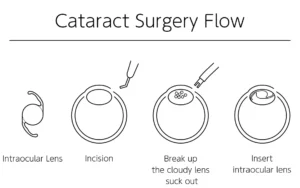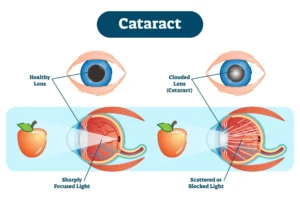Everyone is born with a natural, crystalline lens located behind the iris and in front of the vitreous body in the eye. The primary responsibility of the lens is to help refract and focus light into the back of the eye (also known as the retina), which is then sent to the brain via the optic nerve to produce a clear image.
As we age, this normally-clear lens becomes cloudy as proteins in the lens begin to break down and clump together. This complicates the process of refracting light into the retina, making it harder for light to pass through and ultimately leading to a blurred, distorted, dull, faded, foggy, and/or clouded image.
While there are various types and causes of cataracts, most cases are a result of the natural aging process – in fact, nearly 4 in 5 people will experience a cataract in one or both eyes by the age of 80. Don’t worry, cataract treatments do exist and cataract surgery can help preserve your vision long-term.
What is Cataract Surgery?
A cataract can severely impact an individual’s ability to see clearly. Although symptoms might not be noticeable at first, those symptoms will worsen over time – especially if not diagnosed and treated in a timely manner. That’s why many ophthalmologists suggest cataract surgery to avoid further vision loss.
Cataract surgery is a procedure that involves removing the cloudy lens in the eye and replacing it with a clear artificial lens – also known as an intraocular lens (IOL). It’s a safe and effective procedure that has a >99% success rate. Complications are extremely rare, but can usually be corrected with further surgery.
There are three primary types of IOLs. Monofocal IOLs can correct a single vision problem (nearsighted or farsighted), toric IOLs can correct astigmatism, and presbyopia-correcting IOLs can correct distance and near vision. Your doctor will go over each of your options before beginning the procedure.
When to Have Cataract Surgery
Most doctors will recommend cataract surgery the moment the cataracts start to have a negative impact on the individual’s ability to live a normal life. If you notice your cataracts impeding your day-to-day routine – such as driving a vehicle or reading a book. At the end of the day, it’s the patient’s decision to make.
With that said, here are some of the most common warning signs that it’s time to consider cataract surgery:
- Blurry vision, cloudy vision, and/or double vision
- Light sensitivity and/or glares or halos in visual field
- Difficulty seeing at night or in dimmed areas
- Colors fading or appearing washed out
- Your vision makes it difficult to carry out everyday tasks
While glasses and/or contact lenses can help alleviate some of the symptoms experienced with cataracts, there comes a time when basic vision correction isn’t enough. And since many older patients often regret waiting too long to have cataract surgery, most doctors recommend having it sooner, rather than later.
What to Expect With Cataract Surgery
Before an eye surgeon can begin the procedure for cataract surgery, they must first examine the eye to get a clear idea of what type of lens the patient needs, determine the depth of the cataract, and ensure the eyes are healthy enough for surgery. They’ll also perform a series of tests before moving forward.
Let’s take a look at a step-by-step breakdown of what patients can expect during cataract surgery:
- Patient is given numbing eye drops.
- Doctor makes a small incision in the affected eye.
- Phacoemulsification probe is inserted into the eye, and ultrasound waves are used to break up and remove the clouded lens.
- New intraocular lens is inserted into the eye via the same incision.
- Patient is given an eye shield to help protect the affected eye.
- Patient spends the next 15-30 minutes resting before being sent home.
Patients are awake during the surgery, but don’t worry – it’s not a painful surgery and the numbing eye drops ensure patients experience little-to-no discomfort. With that said, it’s common to feel a little pressure around the eye. And since it’s an outpatient procedure, patients are free to go home after.
How Long Does Cataract Surgery Take?
Being an outpatient procedure, traditional cataract surgery isn’t a procedure that will keep you in the surgeon’s office all day long. In fact, the actual procedure only takes about 10-15 minutes per eye – keep in mind, doctors will only operate on one eye at a time. If you have cataracts in both eyes, you’ll need two appointments.
Of course, that time estimate doesn’t account for pre-surgery and post-surgery responsibilities – which adds roughly 30-45 minutes to the appointment. Pre-surgery is when the doctor administers eye drops and prepares you for surgery, while post-surgery involves recovering from any administered systemic anesthesia.
With that said, you can expect your cataract surgery appointment to take approximately 60-90 minutes. Considering how impactful the results are to your quality of life, that’s not a bad trade off – especially since cataract surgery is permanent.
How Long Does it Take to Recover From Cataract Surgery?
One of the first questions we get asked after undergoing cataract surgery is how long the recovery process takes. While it generally takes four to six weeks for the eye to completely heal following cataract surgery, most patients can expect an improvement in vision right away and the improvement will continue. In fact, the bulk of the healing happens over a few days to a week after surgery.
Your ophthalmologist or eye doctor will go over specific directions to ensure a successful and quick recovery process. This will likely include avoiding swimming, driving, exercising, rubbing the eyes, and wearing eye makeup. You’ll also be asked to take eye drops regularly and take precautionary steps to prevent complications.
Don’t worry, you’ll be able to pick back up with most of these activities after a week – you won’t have to avoid them for the full 4-6 weeks. At the end of the day, everyone’s recovery and healing process will look different, but your doctor and surgeon will be by your side to help you along the way.
If you’d like to learn more about laser cataract surgery and/or believe you’d be a good candidate for cataract removal, please contact Milwaukee Eye Surgeons by calling our office at 414-377-5550, emailing us at info@milwaukeeeyesurgeons.com, or booking an appointment with Dr. Weinlander through our online form.





